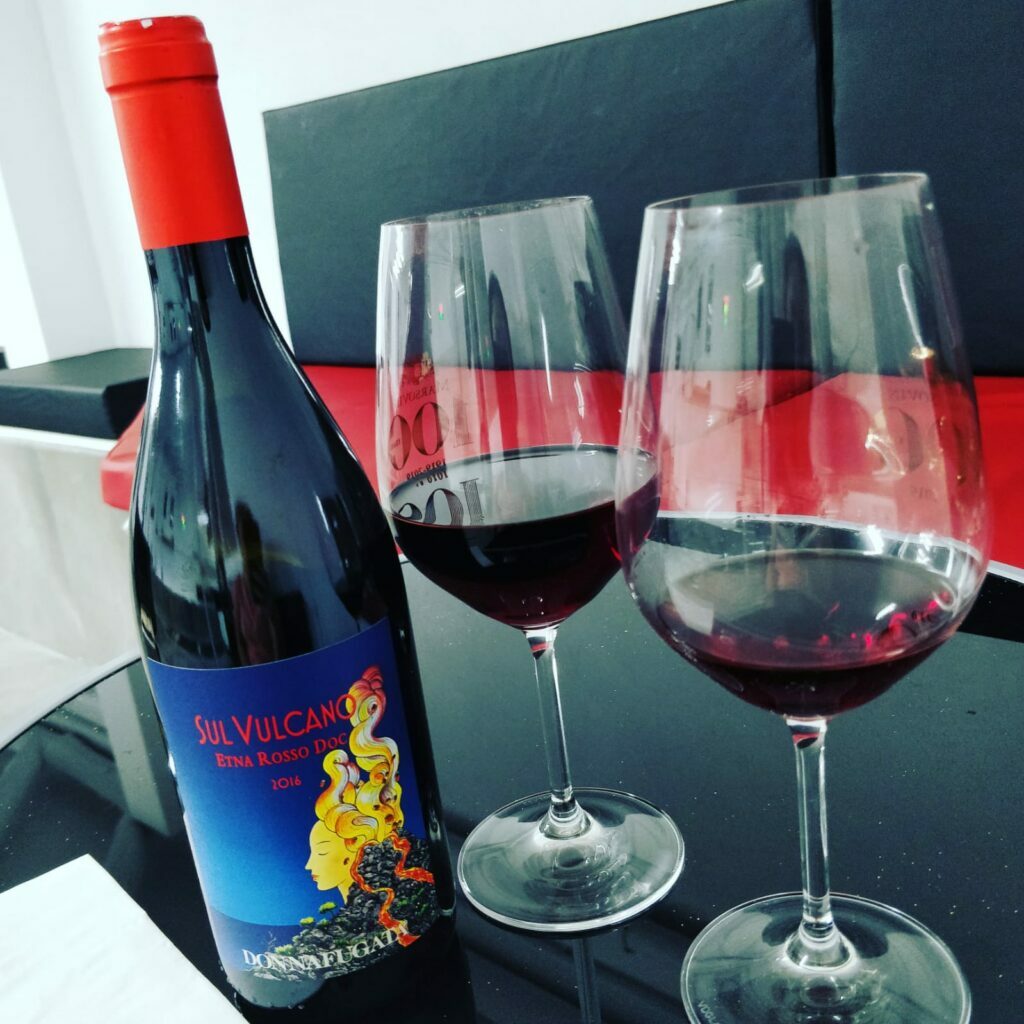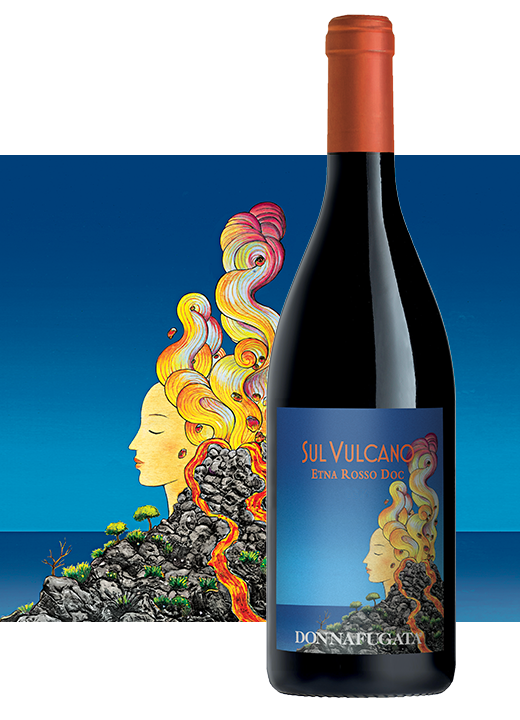
Donnafugata Sul Vulcano
Today, after a hard long week, we opened a wonderful bottle of Donnafugata Sul Vulcano, and hey it didn’t disappoint:)
From the producer (Donnafugata):
VARIETAL
Etna Rosso DOC made of Nerello Mascalese and a small percentage of Nerello CappuccioTASTING NOTES
The palate is soft and enveloping; a balanced, persistent finishFOOD AND WINE PAIRING
Perfect with mediterranean antipasti and first courses based on eggplant or mushrooms, meat and roast stew. Pairing options are numerous: from North-American cuisine (chicken wings, hamburgers) to moderate spicy Asian dishes (beef stir-fried, dumplings) to fusion cuisine like Tex-Mex based on meat and beans.SERVING SUGGESTIONS
Ideally served at 18°C/64°C.AGEING POTENTIAL
This wine can be appreciated from now or can be kept in the cellar for over 5 years.

About Nerello Cappuccio – Nerello Mascalese Wine (Wine Searcher):
Nerello Cappuccio – Nerello Mascalese is a blend of two very Sicilian grape varieties. Together they are the mainstay of quality red wines from Sicily’s east coast, and have long been a popular choice for wines made under the Sicilia IGT title (now promoted to DOC status).
The pair are in fact two mutations of a single variety, although the original archetypal Nerello is rarely referred to in ampelographic literature – or any other kind of literature for that matter. For information on the individual varieties see Nerello Cappuccio and Nerello Mascalese.
The two varieties often grow side-by-side, most commonly in the volcanic soils around Mount Etna (for Etna DOC wines) and on the La Piana di Catania plain just to the south. At the very northeastern tip of Sicily (where the island comes within a mile or two of mainland Italy) the pair are again found together in the hills above the port of Messina. Here they are grown for use in the powerful, yet graceful, red wines sold under the Faro DOC title. Across the Strait of Messina in Calabria, a number of little-known DOCs permit the blend in their red wines. Among these are Lamezia, Sant’Anna di Isola Capo Rizzuto and Savuto.
Both Nerello Cappuccio and Nerello Mascalese can be produced as varietal wines, but they are more commonly blended together to combine their relative merits. Sometimes these blends are boosted significantly with judicious addition of Nero d’Avola, Sicily’s most popular wine grape variety (which sometimes goes by the synonym Nerello Calabrese). Nerello Mascalese is typically the dominant partner in the blend (50-60 percent of the Faro blend and 80 percent of the Etna blend), and is widely regarded as the superior variety of the pair.
Both forms of Nerello are late-ripening, with berries high in both tannin and acids – two key prerequisites for wine intended for aging. Nerello Mascalese has thicker skins than Nerello Cappuccio, and consequently produces wines with higher levels of tannin. Its fruit character tends toward the darker end of the spectrum, making it the more serious of the two. Nerello Cappuccio is slightly more elegant, with its intense, lifted perfume and clearly defined acidity.
Wines made from the two Nerellos in combination tend to have savory, earthy flavors, which have earned them a reputation as being slightly Burgundian. This combines with a heady perfume – more Piedmontese than Burgundian – of red cherries and roses.
About Nerello Mascalese (Wine Searcher):
Nerello Mascalese is a highly regarded, dark-skinned grape variety that grows most commonly on the volcanic slopes of Mount Etna in Sicily. Its wines, which have had a rapid upsurge in popularity in the last decade, have a tendency to reflect their surroundings, giving taut, fresh red wines with fruity, herbaceous flavors, excellent minerality and an earthy nuance. Nerello Mascalese wines often have a perfume reminiscent of those of the noble wines of Barolo and Burgundy.
The variety takes its name from the Mascali plain between Mount Etna and the coast where it is thought to have originated – a small portion of older vines predate the phylloxera epidemic of the 1880s. The prefix Nerello refers to the black color of the grapes, and is shared by Nerello Cappuccio, Nerello Mascalese’s most common blending partner. Both grapes are found in Etna DOC wines, with Nerello Mascalese making up the bulk of the blend and easily surpassing plantings of Nerello Cappuccio (see Nerello Cappuccio – Nerello Mascalese blends).
The hugely variable volcanic soils of Etna combined with elevations of up to 1000m above sea level – some of the highest vineyards in Europe – help produce wines with immense character and complexity, and without the excessive weight that often characterizes Sicilian red wines from lower altitudes. Nerello Mascalese is a late-ripening variety, and most vines are trained in the traditional bush-vine method, which works well in the terroir.
Nerello Mascalese vines also dominate the neighboring Faro DOC surrounding the port city of Messina. Set in the hills above the city, vineyards reach impressive altitudes here too, if not quite the dizzying heights of Etna.
Outside the two aforementioned DOCs, Nerello Mascalese is used in a variety of blends under the Sicilia IGT banner, often alongside the island’s dominant Nero d’Avola grape variety. These wines are most often red, but rosé (rosato) is also made. Across the Strait of Messina in Calabria, the DOCs of Lamezia, Sant’Anna di Isola Capo Rizzuto, and Savuto permit the use of the variety in their respective blends.
Recent DNA testing has suggested that the variety is quite probably the offspring of Italy’s famous Sangiovese grape variety, and a connection to Carricante has also been mooted.
About Nerello Cappuccio (Wine Searcher):
Nerello Cappuccio is a dark-skinned grape variety from Sicily, most famous for its application in the red wines of Etna and Faro. It is rarely found as a varietal wine, and usually plays second fiddle to its cousin Nerello Mascalese, which is more numerous in plantings and considered to be of a higher quality. On its own, Nerello Cappuccio makes a wine that is soft and richly colored, with some cherry flavors on the palate.
The variety thrives in the volcanic soils of Mount Etna, particularly at higher altitudes. Here, the combination of soil and climate result in elegance and structure in the wines. It ripens slightly earlier than Nerello Mascalese, and buds reasonably early; spring frost can sometimes be an issue. However, Nerello Cappuccio is capable of reaching higher-than-average acidity and has plenty of tannin, making it a good choice for vinification.
Nerello Cappuccio lends its color and perfume to Etna’s blended wines, as well as softening out some of Nerello Mascalese’s harder edges (see Nerello Cappuccio – Nerello Mascalese blend). These wines often have an evocative perfume, sometimes likened to those of the noble wines of Barolo and Burgundy. There are a few varietal examples of Nerello Cappuccio made in Sicily, but the grape’s long-standing reputation as a blending variety mean these have only started to appear in the last couple of decades. These are mostly labeled under the Sicilia IGT title, as are the few rosato examples.
Outside Sicily, Nerello Cappuccio is also grown in a few Calabria DOCs: Lamezia, Sant’Anna di Isola Capo Rizzuto and Savuto.